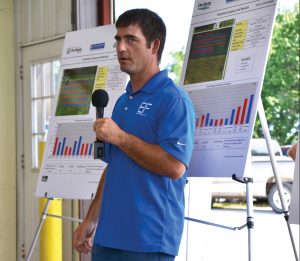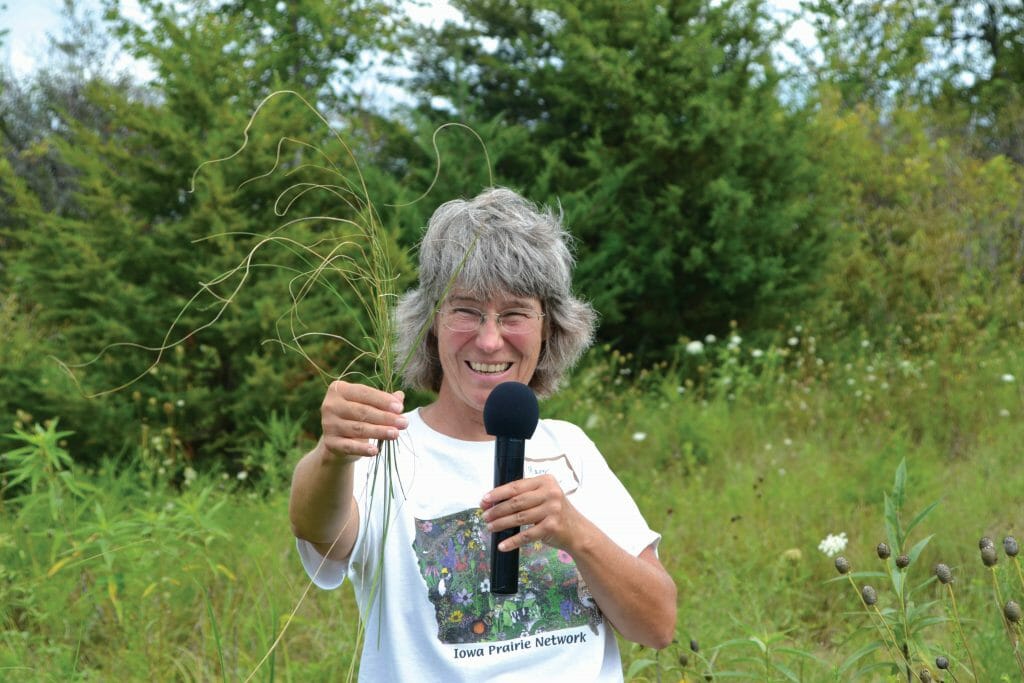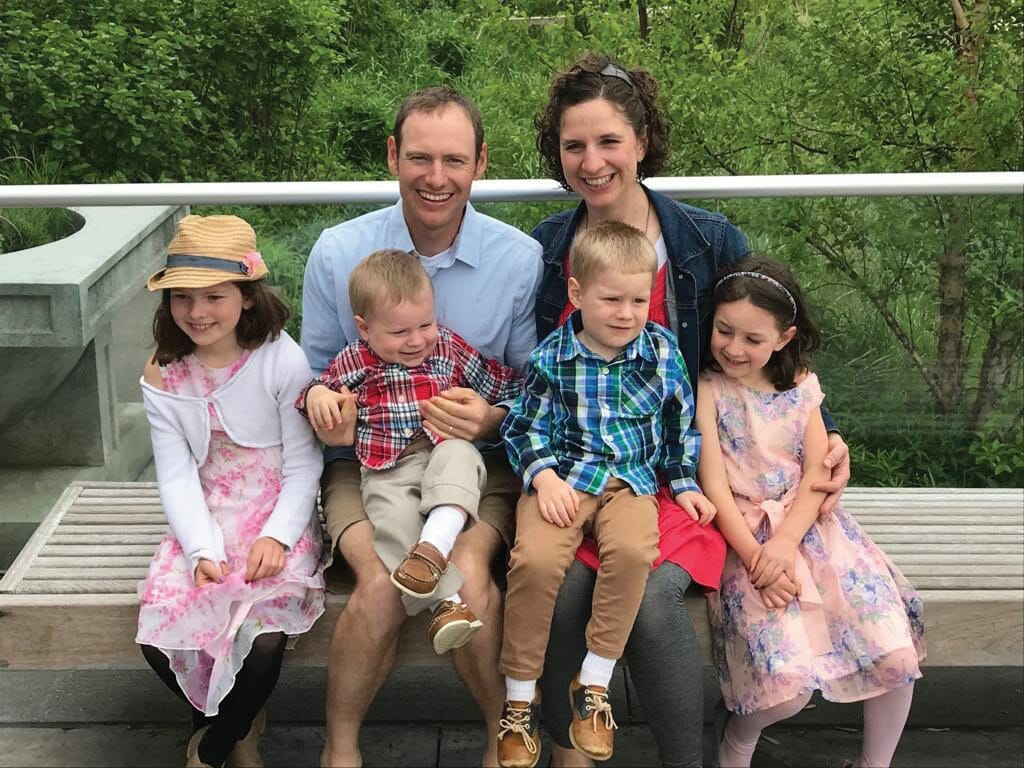Measuring Conservation on the Farm
PFI members share why and how they monitor on-farm conservation efforts
Most farmers are no strangers to monitoring the agronomics of the farm. But what about measuring the impacts of conservation?
Recent years have seen an influx of tools and aides designed to help farmers monitor the effects of their conservation actions, but questions still remain about why, when and how to measure the impacts of on-farm conservation.
Why Measure Conservation?

A.J. Blair shares results of the family’s on-farm research and water quality monitoring during a PFI field day they hosted in 2018.
There are many benefits to measuring and evaluating the effects of on-farm conservation. First and foremost is the fact that many producers simply want to know what’s happening on their farms. “Some people might say ‘stay out of my field’,” explains PFI lifetime member A.J. Blair. “But I take a different approach: If it’s a focus or a concern, then I should know my own data before someone else does and be proactive rather than reactive.”
A.J. says the family has always been conservation-minded, and that trying new things in their production systems slowly led to increased conservation (and more conservation monitoring), largely due to the family’s long-term partnership with Iowa Soybean Association.
“It started with agronomic trials with ISA’s On-Farm Network, and then they approached us to start doing some water monitoring,” A.J. says. For the Blairs, it was an easy next step that helps them identify what’s happening on the farm – and perhaps more importantly, what’s leaving their land.
“If it’s a focus or a concern, then I should know my own data before someone else does and be proactive rather than reactive.” – A.J. Blair
Mary Damm, who owns land near McGregor, has a similar motivation. A botanist and plant ecologist by training, Mary is keen to know what’s happening on her land, either as a result of or despite her tenants’ grazing activities. From soil health and water infiltration to plant diversity and wildlife usage, Mary seeks to understand how the ecology of her farm is affected by grazing on the farm.
“It’s a learning process trying to figure out what was working and what wasn’t working,” Mary says. “And changing timing and methods to figure out what benefited the prairie and the birds the most.”
Torray Wilson and his family take a similar approach. The Wilsons operate a diversified crop and livestock farm near Paullina, and Torray says monitoring and evaluation are key components of their Holistic Management decision-making framework. Torray likens the process to driving a car on a long trip.
First you have to set a destination and check the car to make sure everything is working. Then as you start driving, you constantly make adjustments based on information gathered from your surroundings. Is the road bumpy? What is traffic like? Do you need to speed up or slow down? Do you need to take a detour?
“When you’re driving a car, you don’t consciously monitor for all that information,” Torray explains. “Just like when we farm, we’re constantly taking in information and scanning for problems.” But like a new driver, the ability to process and evaluate this information is a skill and habit learned over time, and that learning curve can be steep.
Challenges and Solutions
Gathering information on the farm is a first step – but knowing what to do with it and understanding how to evaluate the results of any monitoring efforts pose an entirely new set of challenges. For example, Mary Damm says she has struggled with interpreting and applying the results of soil tests taken on her farm.
“I was very interested in soil health on my farm, so we did several Haney tests at different locations,” Mary says. “But it was frustrating, because even though I’ve studied soils, I had a difficult time interpreting the results.”
“One of our biggest challenges is having the self-discipline to stop working in the business and start working on the business.” – Torray Wilson
Mary eventually concluded that her problem was due to a common monitoring challenge: a lack of baseline information. Without a baseline for comparison, it can be hard to interpret the data gathered as part of a conservation monitoring program. To address this lack of context, Mary has started testing more and different parts of her farm – including areas she and her farm manager know were never plowed. These remnant areas may provide a baseline against which samples from her pastures and reconstructed prairies can be compared.
A.J. Blair and his family are also in the process of collecting baseline data. A.J. notes that as their efforts mature, they are getting better at collecting only the data that’s relevant to the questions they want to answer. This is another challenge for any monitoring program: Simply collecting data is relatively straightforward, but having the right data in a useful form is much more difficult. “Collection is good, but we can collect so much stuff that a lot of it can become unusable,” A.J. says. “We really have to think about what things we can control and whether or not collecting data on things we can’t control is worth it.”
Monitoring also takes time and resources in a profession where time and resources are at a premium. Torray says that monitoring and evaluating all aspects of the farm, including conservation efforts, must be habitual or it’s likely to get skipped in favor of more pressing tasks. “One of our biggest challenges is having the self-discipline to stop working in the business and start working on the business,” Torray says. “It’s hard to get off the hamster wheel and take a step back, and that’s where the framework of Holistic Management helps us.”
You Don’t Have to Do It Alone
Torray, A.J. and Mary all have different operations and priorities for their farms, including different conservation goals. But they share a common attribute: They’re not alone in their monitoring efforts. “To have a successful trial, you have to be able to set things up correctly,” A.J. says. “That’s where Iowa Soybean Association and Practical Farmers have really helped us.”
“The surveys really provided validation and hard evidence that we had been doing good work. To me, that we have a working farm and such tremendous bird diversity, is remarkable.” – Mary Damm
On the Blairs’ farm, the water quality monitoring they’re doing with Iowa Soybean Association is completely hands-off. ISA staff pick up samples from the farm and send them to a water lab for analysis. A.J. then gets a report once or twice a year that includes the results at a field scale, as well as aggregate statewide data. The process is quick, efficient and confidential.
For Mary, the expertise of her farm manager – an experienced local farmer and rancher with his own deep-rooted passion for ecology and wildlife – has proven invaluable. Mary has also worked with some local professors to do surveys of wildlife, particularly birds, on her farm. The results have both surprised and energized her.
“The surveys really provided validation and hard evidence that we had been doing good work,” Mary says. “To me, that we have a working farm and such tremendous bird diversity is remarkable.”
Often, the best support comes from friends and family. “We meet once a week with the family,” Torray says. “Without family structure, we don’t have a very stable business structure, and without a strong business it’s impossible to develop and implement more conservation, let alone more monitoring.” He adds that the family also sits down monthly with a neighboring family. “It helps to have someone hold you accountable. It can be really powerful, and ensures that we’re not just sticking our heads in the sand.”
The Bottom Line
Monitoring conservation actions and practices can be difficult and time-consuming, but it can also be rewarding and even critical to meeting farm goals. “We also shoot for continual improvement,” A.J. says, “and that in itself makes the farming a bit more fun.” A.J. notes that even though it can be a struggle to get everything done, just starting every year knowing they’re going to be doing something different makes the process exciting.
“If I had to give one piece of advice, it would be to not be afraid to try new things,” A.J. says. “Do it on a scale that’s not going to make or break you, then monitor it to see what the results are and go from there.”



